Electricity Sales Package Decision Making Using Two-Stage Density Clustering and Minimum Adjustment Distance Consensus
Abstract
1. Introduction
- (1)
- A sample customer clustering method is proposed, the TSDC algorithm, avoiding the randomness, subjectivity, and associated errors existing in the current density clustering algorithm, which can improve the accuracy of identifying similar customers to the target customer.
- (2)
- Considering the hesitant and fuzzy characteristics of customers’ evaluation information on electricity sales packages, a multi-attribute group decision-making method for electricity sales packages is proposed based on the minimum adjustment distance consensus, realizing the transformation between the customers’ evaluation information and the collective evaluation information, which can improve the accuracy of the group decision making on electricity sales packages.
2. Sample Customer Clustering Based on TSDC
2.1. Customer Portrait Label System Construction
2.2. Sample Customer Clustering Based on TSDC Algorithm
3. Evaluation of Electricity Sales Packages Based on Minimum Adjustment Distance Consensus
3.1. Consensus-Reaching Process of Multi-Attribute Group Decision Making Based on Hesitant Fuzzy Linguistic Term Set
3.2. Determination of Weight of Electricity Sales Package Attributes Based on Entropy Method
4. Full-Ordering Decision Making on Electricity Sales Packages Based on Customer Satisfaction
5. Case Studies
5.1. Background
5.2. Analysis of Group Decision Making on Electricity Sales Packages
5.2.1. Sample Customer Clustering
5.2.2. Sample Customer Clustering
- Option 1: Customers with high total power consumption are more inclined to choose a tiered price package.
- Option 2: Customers with high non-peak power consumption are more inclined to choose time-of-use tariff packages.
- Option 3: In the case of the same price of the electricity sales package, customers with high sensitivity to power quality disturbances are more inclined to choose power quality-improvement services.
- Option 4: When the prices of the electricity sales packages are equivalent, customers are more inclined to choose cost-saving incentive policies.
- Option 5: When the prices of the electricity sales packages are equivalent, customers are more inclined to choose the electricity sales package with a high proportion of new energy.
- Option 6: In the case of the same price of the electricity sales package, customers are more inclined to choose the electricity sales package without the package exit fee.
5.2.3. Sample Customer Clustering
6. Conclusions
- (1)
- The proposed sample customer set partitioning method based on the TSDC algorithm avoids the problems of randomness, subjectivity, and associated errors in the current density clustering algorithm, and improves the accuracy of sample customer set partitioning.
- (2)
- A minimum adjustment distance consensus-reaching process considering the hesitant fuzzy characteristics of customer evaluation information is proposed. The feedback mechanism in this process helps to effectively integrate the customers’ personal views into a collective evaluation, which plays a vital role in the decision-making process for electricity sales packages.
Author Contributions
Funding
Institutional Review Board Statement
Informed Consent Statement
Data Availability Statement
Conflicts of Interest
Nomenclature
| Sample customer set | |
| P | Monthly load data of the sample customer set |
| Monthly load data | |
| Portrait of customer | |
| Euclidean distance between customer and customer | |
| A customer set in which each customer is sorted in ascending order by distance | |
| Similarity between customer and customer | |
| Density threshold between high-density customers and low-density customers | |
| Current number of clusters | |
| A customer set in which each customer is sorted in descending order by density | |
| C | Cluster output matrix |
| Cumulative customer number of the cn-th cluster | |
| Cluster center matrix | |
| High-density customer | |
| Point pair set | |
| The j-th customer in that can form a point pair with | |
| The n-th customer in the m-th class | |
| Attribute set of the electricity sales packages | |
| X | Electricity sales package set |
| Maximum number of language evaluations; it is an odd number | |
| The l-th language evaluation | |
| Linguistic evaluation quantity threshold | |
| Consensus threshold | |
| The s-th evaluation of the k-th attribute of the j-th electricity sales package by the n-th customer in the m-th class | |
| The s-th collective evaluation of the k-th attribute of the j-th electricity sales package by the m-th-class customer | |
| The difference between evaluation and evaluation | |
| The consensus level between the n-th customer in the m-th class and the s-th collective decision | |
| Final collective decision matrix | |
| The evaluation weight of the m-th customer for the k-th package attribute | |
| Index after treatment | |
| The ratio of the j-th electricity sales package to the attribute under the k-th attribute of the m-th customer | |
| The entropy value of the k-th attribute for the m-th customer | |
| The -th customer of similar customers’ satisfaction with the electricity sales package | |
| The deviation of the decision-making result of the electricity package for target customer |
Appendix A
Appendix A.1. Monthly Load Factor
Appendix A.2. Monthly Minimum Load Coefficient
Appendix A.3. Monthly Maximum Load Utilization Hours
Appendix A.4. Peak Period Load Rate Average Value
Appendix A.5. Mean Value of the Minimum Load Coefficient in the Peak Period
Appendix A.6. Valley Period Load Rate Average Value
Appendix A.7. Mean Value of the Minimum Load Coefficient in the Valley Period
Appendix A.8. Flat Period Load Rate Average Value
Appendix A.9. Mean Value of the Minimum Load Coefficient in the Flat Period
Appendix B

Appendix C
- where ,
Appendix D
- where ,
- where and are the 0–1 variables.
Appendix E
| Unit Price/(Yuan·(kW·h)−1) | Percentage of Renewable Energy/% | Value-Added Service | Incentive Policy | Package Exit Fee | |
|---|---|---|---|---|---|
| 0.51 (<500 kW·h) | 15 | Power quality-improvement services | On-time settlement of electricity discount 8% | $160 | |
| 0.63 (500–1000 kW·h) | |||||
| 0.82 (>1000 kW·h) | |||||
| 0.58 (<500 kW·h) | 20 | Energy-saving management | Reward power ratio of 9% | $170 | |
| 0.6 (500–1000 kW·h) | |||||
| 0.86 (>1000 kW·h) | |||||
| 0.87 (peak: 10:00–12:00, 13:00–19:00) | 10 | Energy-saving management | On-time settlement of electricity discount 8% | none | |
| 0.60 (flat: 06:00–10:00, 12:00–13:00, 19:00-22:00) | |||||
| 0.31 (valley: 22:00–morrow 06:00) | |||||
| 0.82 (peak: 08:00–15:00, 17:00–21:00) | 15 | Power quality-improvement services | Reward power ratio of 9% | none | |
| 0.64 (flat: 6:00–08:00, 15:00–17:00, 21:00-22:00) | |||||
| 0.33 (valley: 22:00–morrow 06:00) |
Appendix F
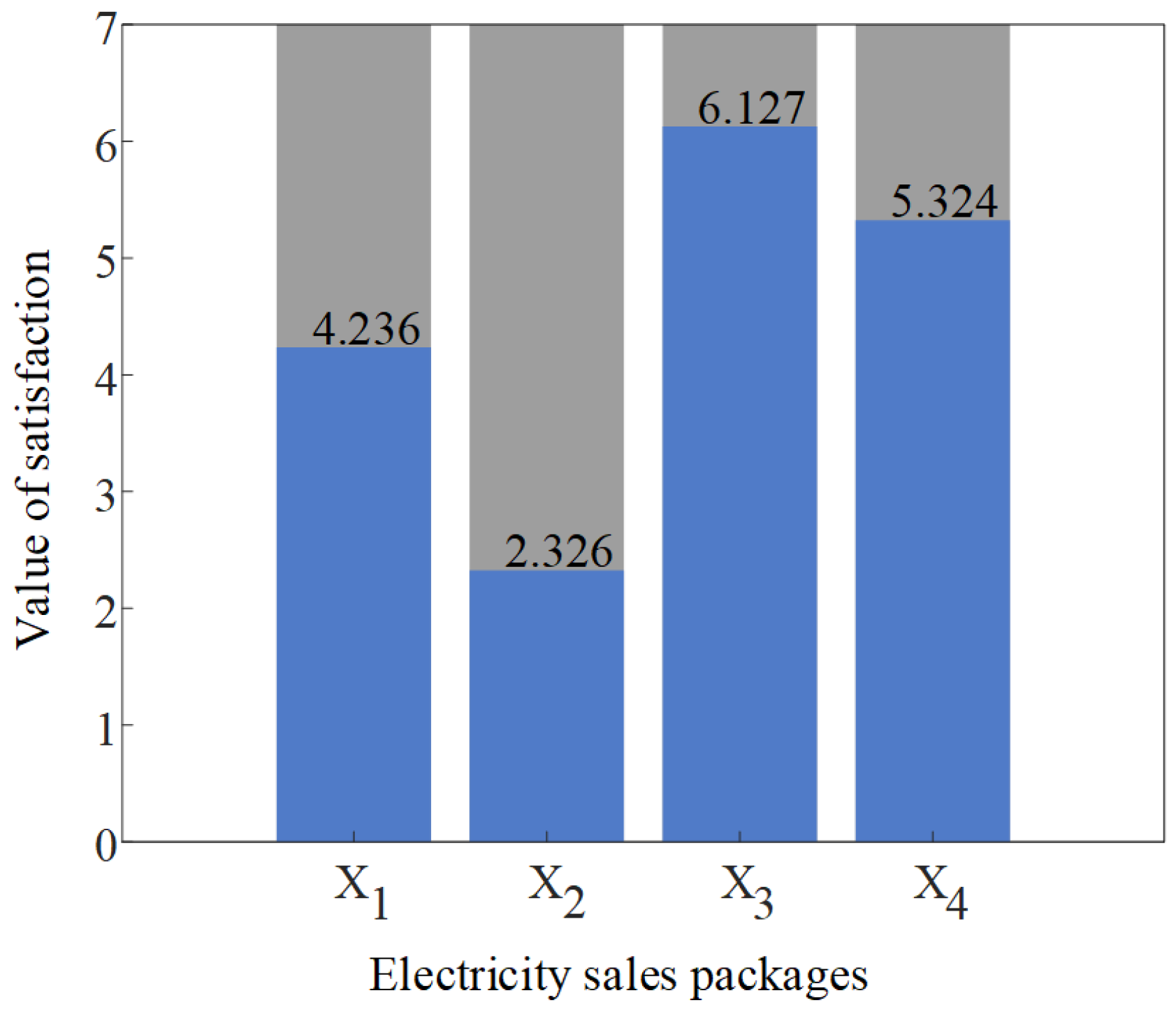
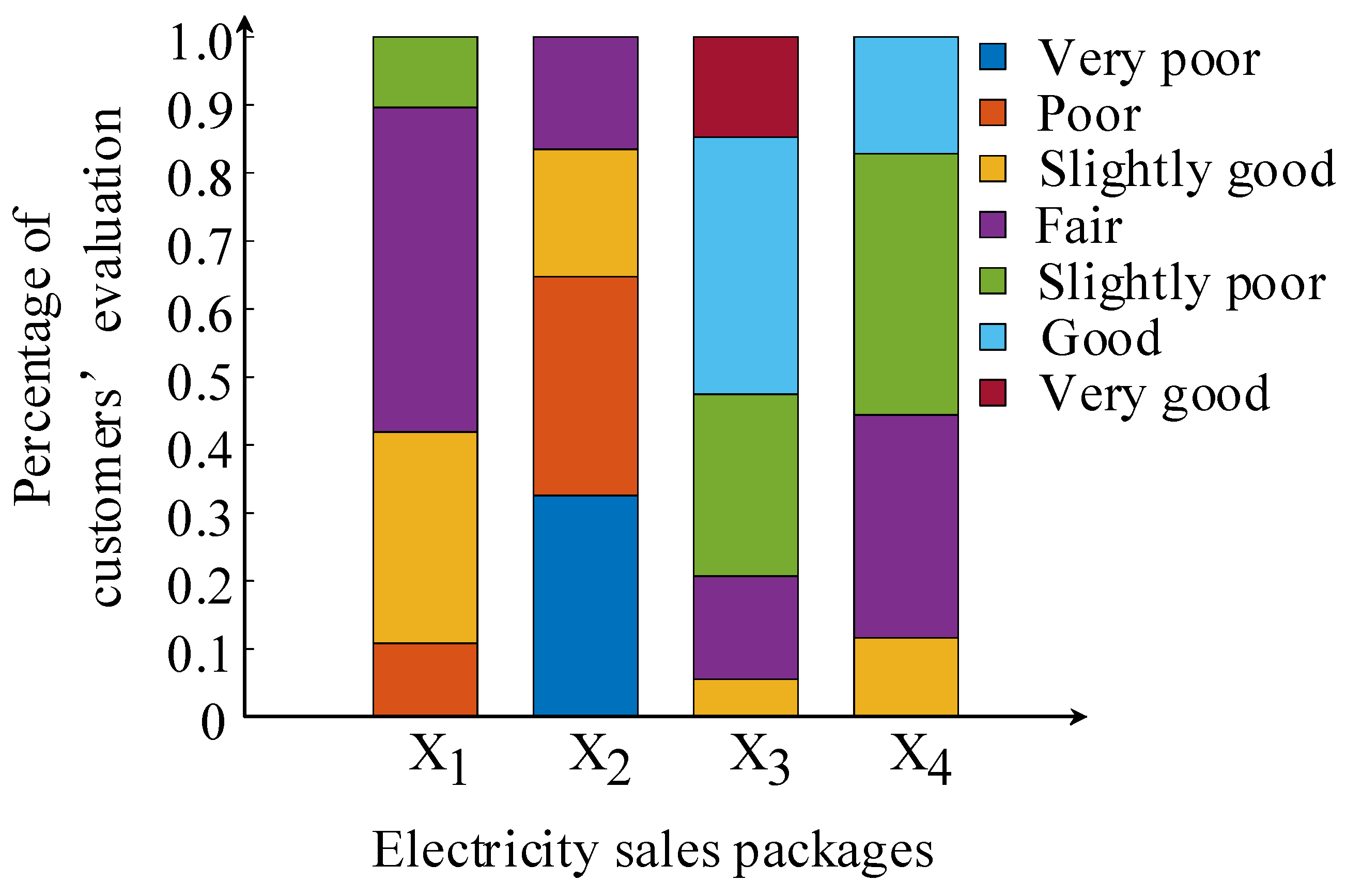
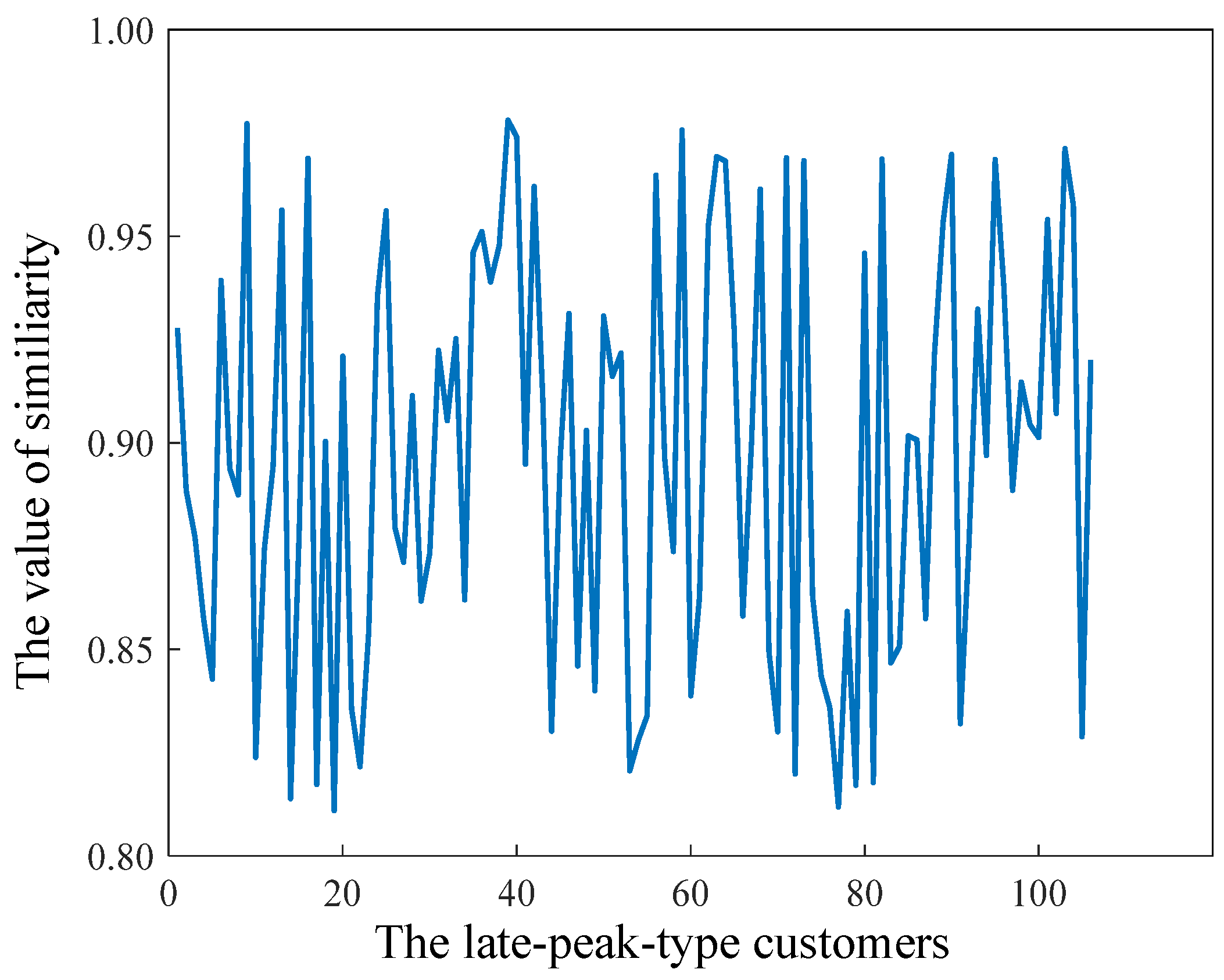
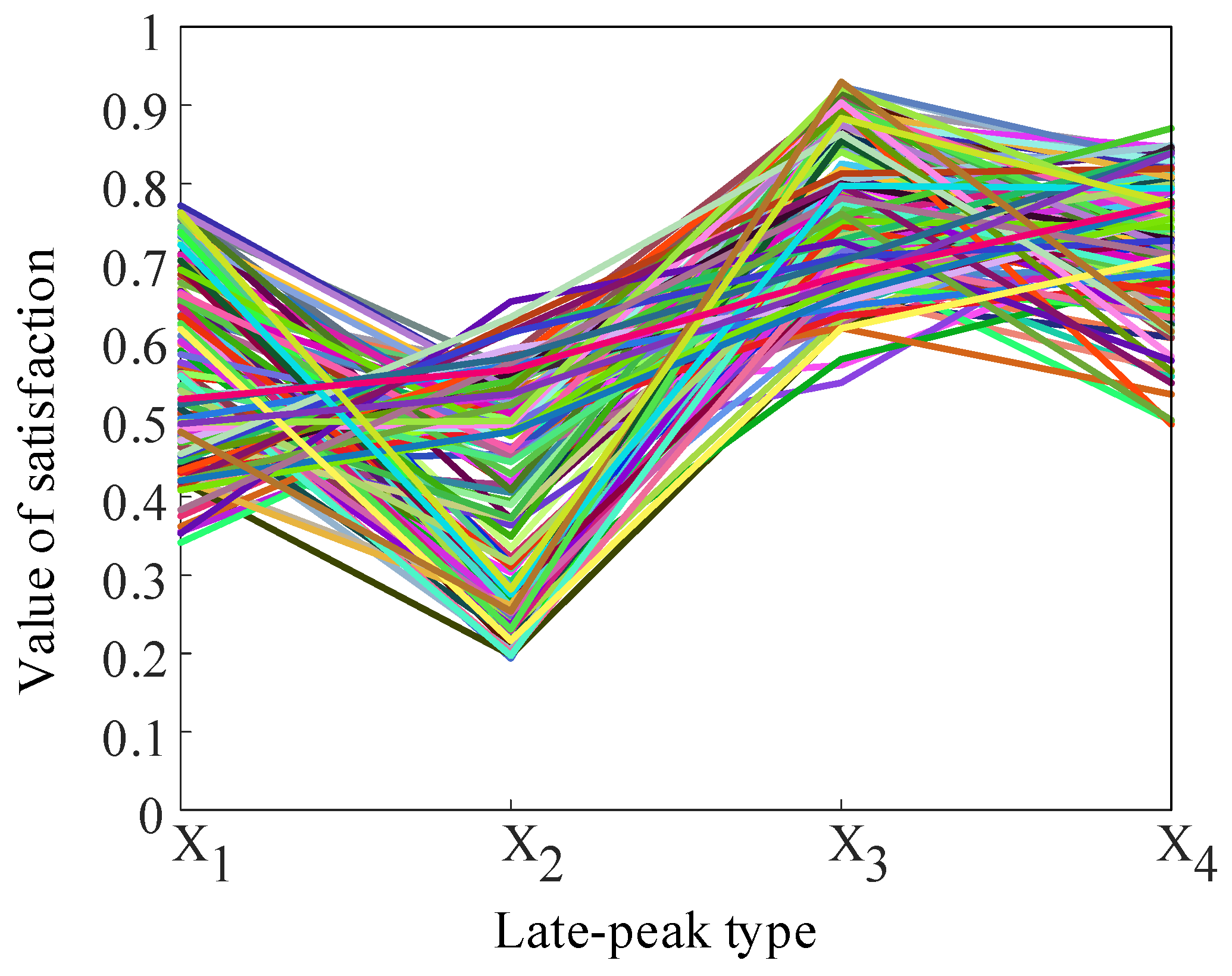
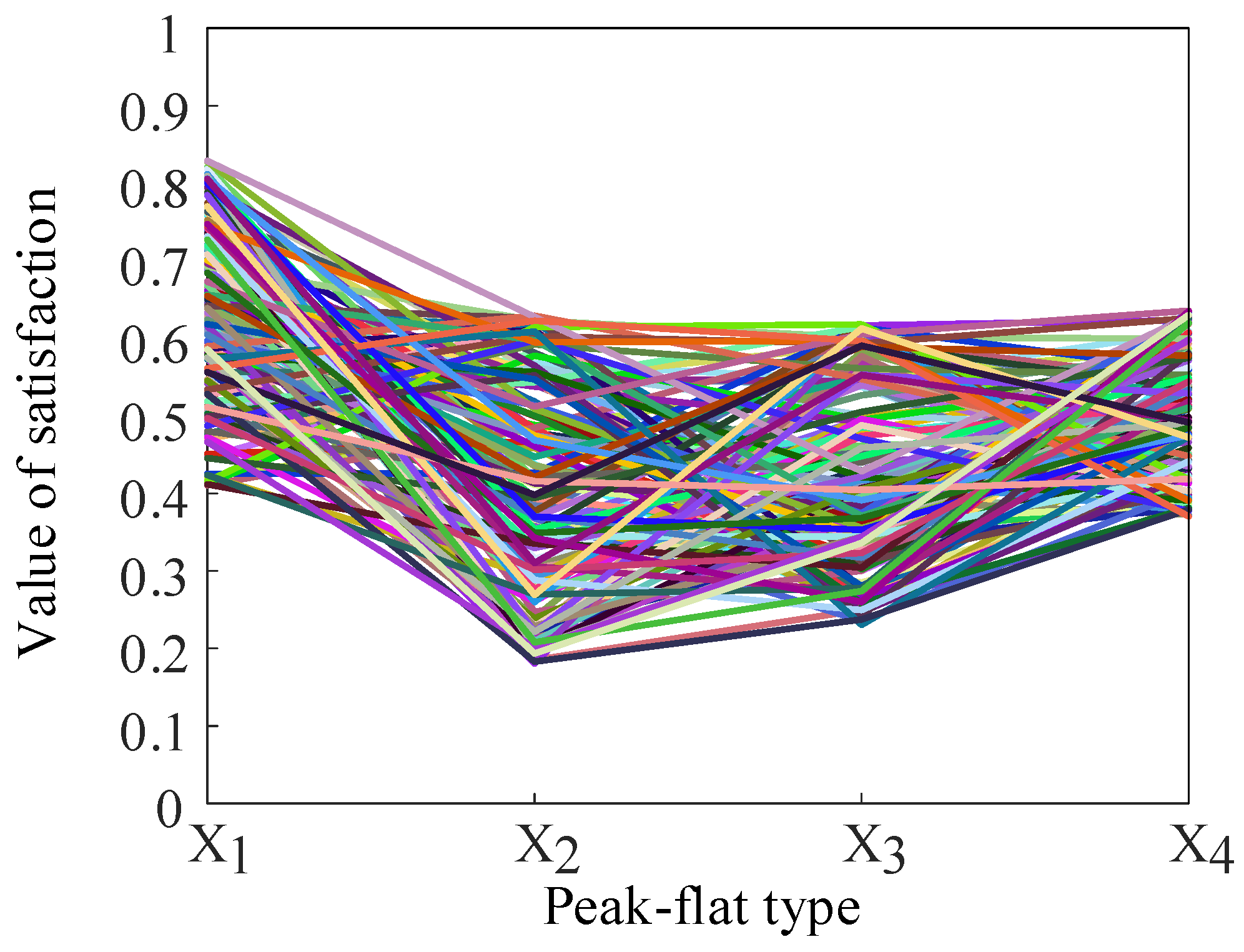
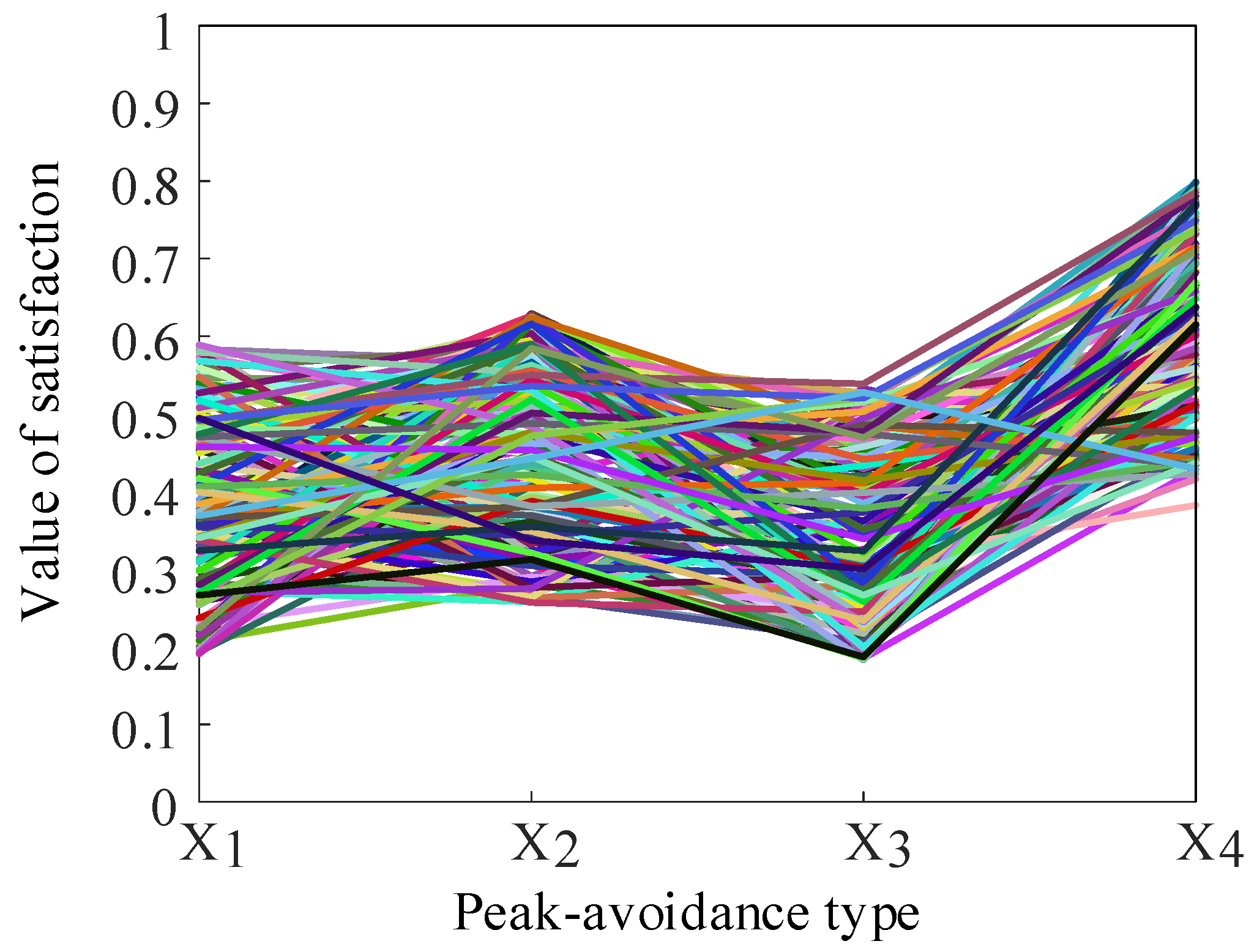
References
- Yin, C.; Yang, D.; Geng, G.; Fan, Z. Summary of energy internet projects in Germany and its enlightenment to China. Power Syst. Technol. 2015, 39, 3040–3049. [Google Scholar]
- Ning, Y.; Ying, G.; Yan, G. Recommending Electricity Plan: A Significant Nearest Neighbors Collaborative Filtering Method. In Proceedings of the 2021 3rd International Conference on Smart Power & Internet Energy Systems (SPIES), Shanghai, China, 25–28 September 2021; pp. 353–357. [Google Scholar]
- iSelect. 2019. Available online: http://www.iselect.com.au/energy/ (accessed on 11 December 2023).
- Power to Choose. 2019. Available online: https://www.powertochoose.org (accessed on 12 December 2023).
- Energy Made Easy. 2019. Available online: http://www.energymadeeasy.gov.au (accessed on 15 December 2023).
- Check24. 2019. Available online: http://www.check24.de/strom/gas/ (accessed on 7 January 2024).
- Eprimo. 2023. Available online: https://www.eprimo.de/ (accessed on 7 January 2024).
- Entega. 2023. Available online: https://www.entega.de/ (accessed on 7 January 2024).
- Yi, S.; Wei, G.; Bin, L. Electricity-Retail-Market-Reform Oriented Recommendation Method of User’s Hierarchical Clustering and Pricing Packages. Grid Technol. 2018, 2, 447–454. [Google Scholar]
- Luo, F.; Ranzi, G.; Wang, X.; Dong, Z.Y. Social information filtering-based electricity retail plan recommender system for smart grid end users. IEEE Trans. Smart Grid 2017, 10, 95–104. [Google Scholar] [CrossRef]
- Wang, J.F. Practice of Machine Learning Algorithm-Collaborative Filtering Theory of Recommendation System and Its Application; Tsinghua University Press: Beijing, China, 2019. [Google Scholar]
- Zhang, Y.; Meng, K.; Kong, W.; Dong, Z.Y. Collaborative filtering-based electricity plan recommender system. IEEE Trans. Ind. Inform. 2018, 15, 1393–1404. [Google Scholar] [CrossRef]
- Zhang, Y.; Meng, K.; Kong, W.; Dong, Z.Y.; Qian, F. Bayesian hybrid collaborative filtering-based residential electricity plan recommender system. IEEE Trans. Ind. Inform. 2019, 15, 4731–4741. [Google Scholar] [CrossRef]
- Wu, Y.; Liao, M.; Hu, M.; Lin, J.; Zhou, J.; Zhang, B.; Xu, C. A decision framework of low-speed wind farm projects in hilly areas based on DEMATEL-entropy-TODIM method from the sustainability perspective: A case in China. Energy 2020, 213, 119014. [Google Scholar] [CrossRef]
- Hao, X.; Quanming, Z.; Qiang, Y.; Ruiguang, M.; Mi, Z.; Wei, Y. A medium and long term load characteristic index forecasting method considering load influencing factors. In Proceedings of the 2020 IEEE Sustainable Power and Energy Conference (iSPEC), Chengdu, China, 23–25 November 2020; pp. 1431–1436. [Google Scholar]
- Herrera, F.; Herrera-Viedma, E. A model of consensus in group decision making under linguistic assessments. Fuzzy Sets Syst. 1996, 78, 73–87. [Google Scholar] [CrossRef]
- Herrera-Viedma, E.; Cabrerizo, F.J.; Kacprzyk, J.; Pedrycz, W. A review of soft consensus models in a fuzzy environment. Inf. Fusion 2014, 17, 4–13. [Google Scholar] [CrossRef]
- Zhang, B.; Dong, Y.; Xu, Y. Multiple attribute consensus rules with minimum adjustments to support consensus reaching. Knowl.-Based Syst. 2014, 67, 35–48. [Google Scholar] [CrossRef]
- Dong, Y.; Chen, X.; Herrera, F. Minimizing adjusted simple terms in the consensus reaching process with hesitant linguistic assessments in group decision making. Inf. Sci. 2015, 297, 95–117. [Google Scholar] [CrossRef]
- Ben-Arieh, D.; Easton, T.; Evans, B. Minimum cost consensus with quadratic cost functions. IEEE Trans. Syst. Man Cybern.-Part A Syst. Hum. 2008, 39, 210–217. [Google Scholar] [CrossRef]
- Wu, C.X.; He, S.Y. UD-OPTICS: An uncertain data clustering algorithm based on interval number. Comput. Eng. Sci. 2019, 41, 1303–1311. [Google Scholar] [CrossRef] [PubMed]
- Parmar, M.; Wang, D.; Zhang, X.; Tan, A.-H.; Miao, C.; Jiang, J.; Zhou, Y. REDPC: Density clustering algorithm based on dual errors. Neurocomputing 2019, 348, 82–96. [Google Scholar] [CrossRef]

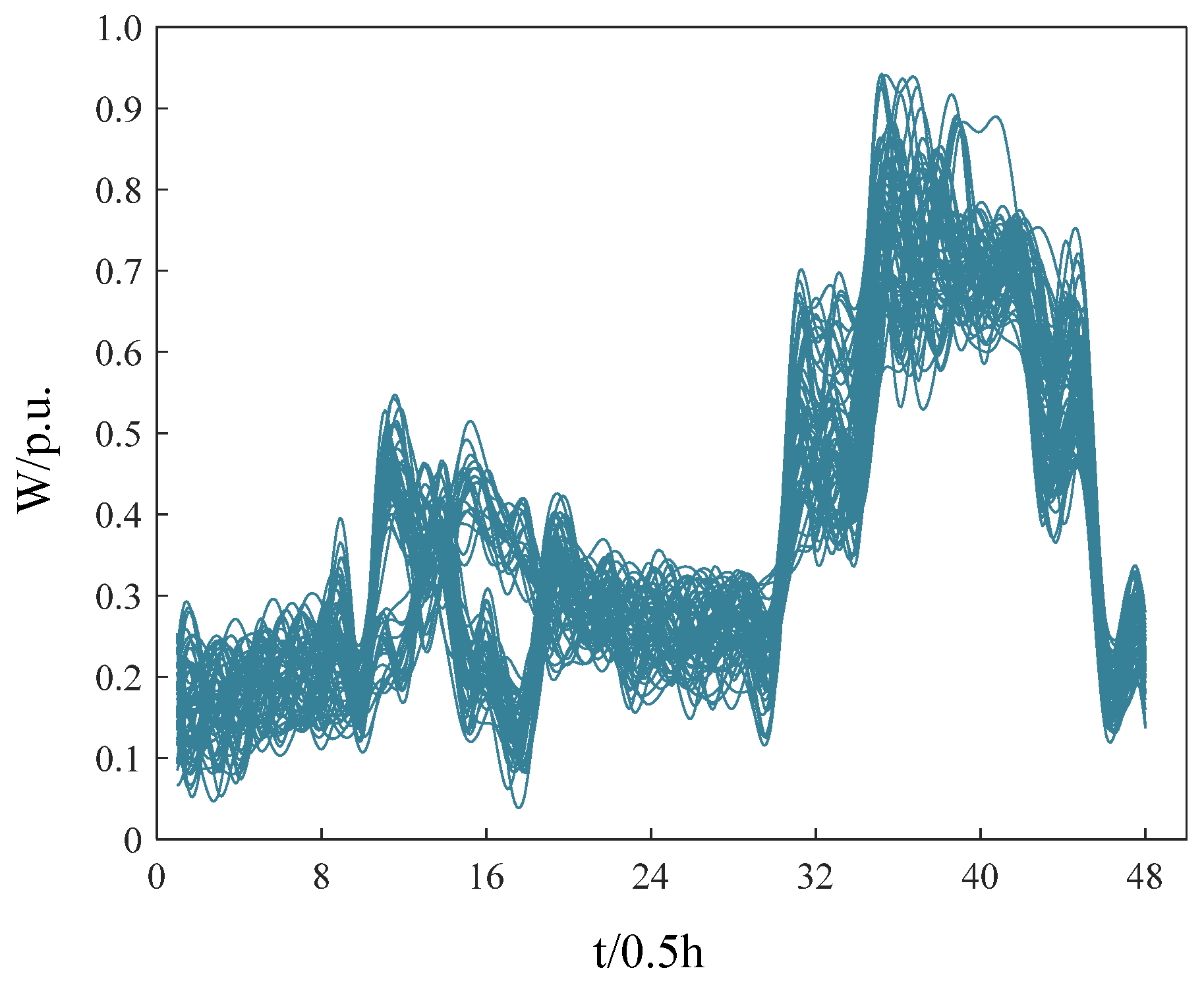
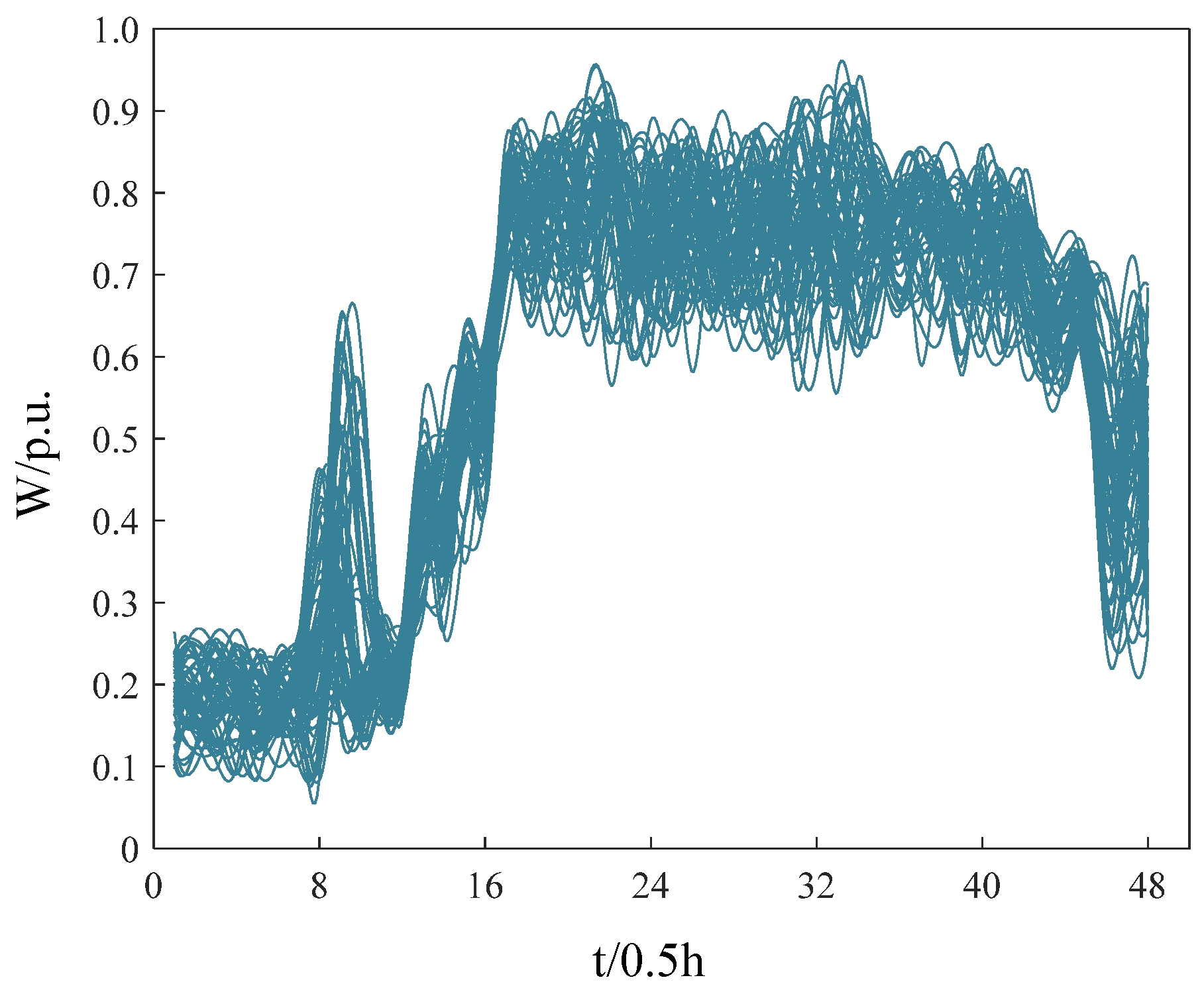
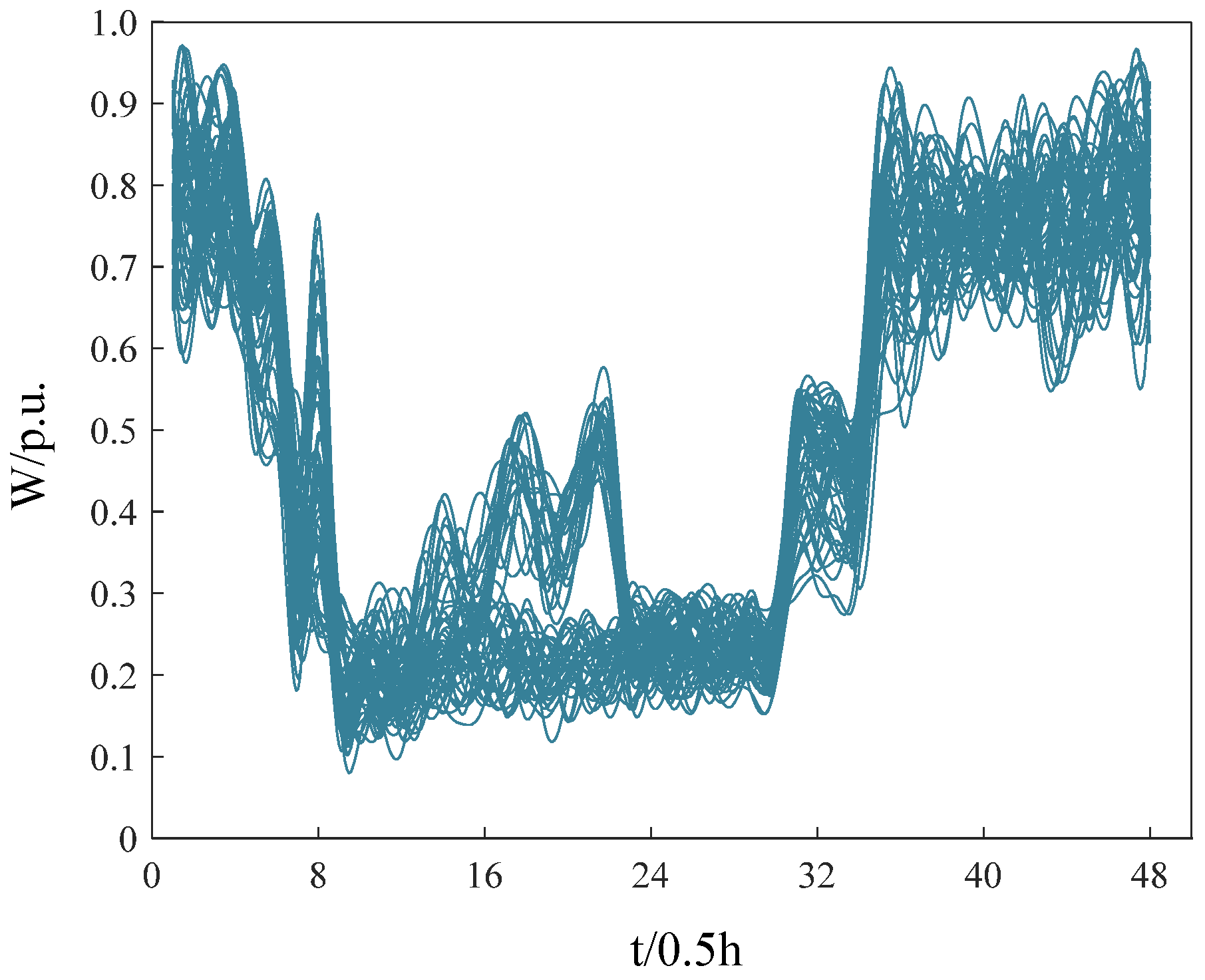
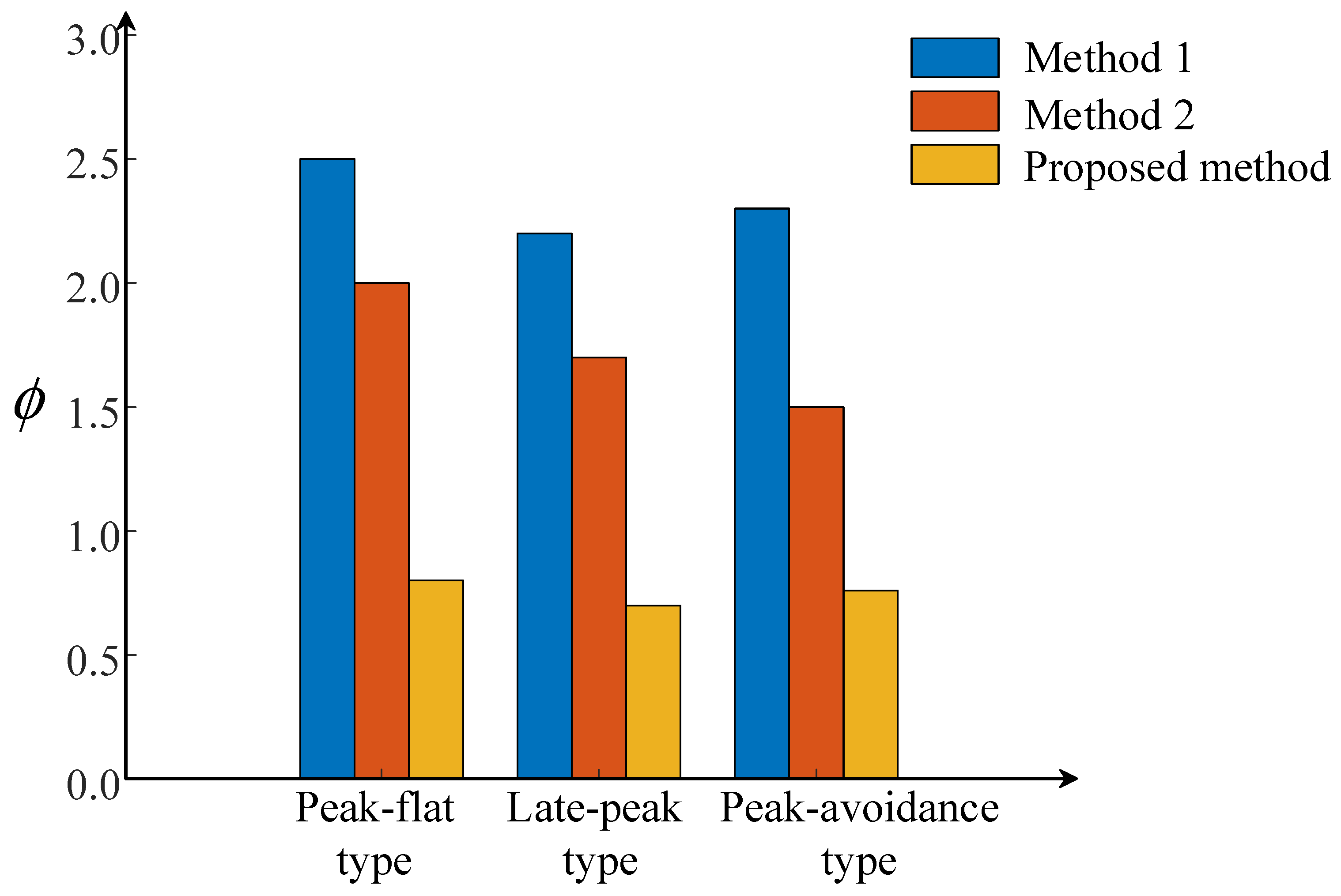
| Label | Physical Meaning | Definition |
|---|---|---|
| Monthly load factor | Fluctuation of monthly load | |
| Monthly minimum load factor | Stability of customers’ electricity consumption | |
| Monthly peak load utilization hours | Monthly load time utilization efficiency | |
| Average peak load factor | Load fluctuation in peak period (8:30–11:30; 18:00–23:00) | |
| Average valley load factor | Power consumption stability of customers during peak period | |
| Average flat load factor | Load fluctuation in valley period (23:00–24:00; 0:00–7:00) | |
| Average peak minimum load factor | Power consumption stability of customers during valley period | |
| Average valley minimum load factor | Load fluctuation in flat period (7:00–08:30; 11:30–18:00) | |
| Average flat minimum load factor | Power consumption stability of customers during flat period |
| Electricity Sales Packages | X1 | X2 | X3 | X4 |
| Target customer satisfaction | 0.6913 | 0.3796 | 1.0000 | 0.8690 |
| Electricity Sales Packages | Recommendation Ranking of This Paper | Actual Ordering of Simulations |
|---|---|---|
| X1 | 3 | 3 |
| X2 | 4 | 4 |
| X3 | 1 | 1 |
| X4 | 2 | 2 |
Disclaimer/Publisher’s Note: The statements, opinions and data contained in all publications are solely those of the individual author(s) and contributor(s) and not of MDPI and/or the editor(s). MDPI and/or the editor(s) disclaim responsibility for any injury to people or property resulting from any ideas, methods, instructions or products referred to in the content. |
© 2024 by the authors. Licensee MDPI, Basel, Switzerland. This article is an open access article distributed under the terms and conditions of the Creative Commons Attribution (CC BY) license (https://creativecommons.org/licenses/by/4.0/).
Share and Cite
Wang, K.; Hu, X.; Ma, Y. Electricity Sales Package Decision Making Using Two-Stage Density Clustering and Minimum Adjustment Distance Consensus. Appl. Sci. 2024, 14, 5747. https://doi.org/10.3390/app14135747
Wang K, Hu X, Ma Y. Electricity Sales Package Decision Making Using Two-Stage Density Clustering and Minimum Adjustment Distance Consensus. Applied Sciences. 2024; 14(13):5747. https://doi.org/10.3390/app14135747
Chicago/Turabian StyleWang, Kesheng, Xinyu Hu, and Yuanqian Ma. 2024. "Electricity Sales Package Decision Making Using Two-Stage Density Clustering and Minimum Adjustment Distance Consensus" Applied Sciences 14, no. 13: 5747. https://doi.org/10.3390/app14135747
APA StyleWang, K., Hu, X., & Ma, Y. (2024). Electricity Sales Package Decision Making Using Two-Stage Density Clustering and Minimum Adjustment Distance Consensus. Applied Sciences, 14(13), 5747. https://doi.org/10.3390/app14135747




